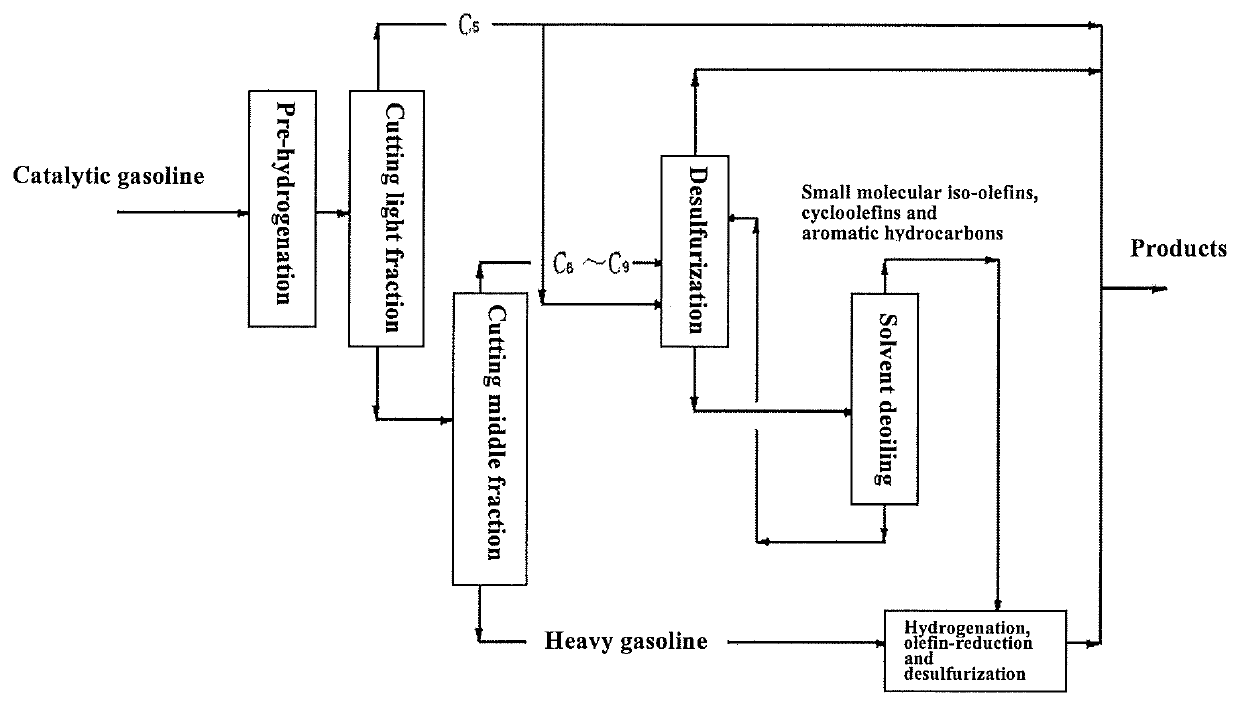Catalytic gasoline desulfurization method having also an olefin selective removal function
a technology of catalytic gasoline and desulfurization method, which is applied in the field of petrochemicals, can solve the problems of increasing human health threats, increasing pollution caused by emissions, and upgrading gasoline quality, and achieves selective separation of olefin and high solubility
- Summary
- Abstract
- Description
- Claims
- Application Information
AI Technical Summary
Benefits of technology
Problems solved by technology
Method used
Image
Examples
example 1
[0037]A catalytic gasoline desulfurization method having also an olefin selective removal function, the process flow of which is shown as the FIG. 1, specifically comprises the following steps:
[0038](1) Performing the pre-hydrotreatment on the catalytic gasoline: the diene is hydroconverted, and at the same time, the small molecular sulfur is converted to the macromolecule sulfur, so that the sulfur in the light gasoline enters the heavier fraction.
[0039](2) The pre-hydrotreated catalytic gasoline in the step (1) enters the light fraction cutting tower, the light gasoline mainly composed of the C5 fraction is cut at a cutting point of 40° C., the light gasoline is discharged from the top of the light fraction cutting tower, and the residual fraction is discharged from the bottom of the light fraction cutting tower and enters the middle fraction cutting tower.
[0040](3) The middle gasoline mainly composed of C6-C9 fractions is cut at a cutting point of 150° C. in the middle fraction c...
example 2
[0047]A method for desulfurizing catalytic gasoline with a function of selectively removing olefins, the process flow of which is shown as the FIG. 1, specifically comprises the following steps:
[0048](1) Performing the pre-hydrotreatment on the catalytic gasoline: the diene is hydroconverted, and at the same time, the small molecular sulfur is converted to the macromolecule sulfur, so that the sulfur in the light gasoline enters the heavier fraction.
[0049](2) The pre-hydrotreated catalytic gasoline in the step (1) enters the light fraction cutting tower, the light gasoline mainly composed of the C5 fraction is cut at a cutting point of 50° C., the light gasoline is discharged from the top of the light fraction cutting tower, and the residual fraction is discharged from the bottom of the light fraction cutting tower and enters the middle fraction cutting tower.
[0050](3) The middle gasoline mainly composed of C6-C9 fractions is cut at a cutting point of 160° C. in the middle fraction ...
example 3
[0057]A method for desulfurizing catalytic gasoline with a function of selectively removing olefins, the process flow of which is shown as the FIG. 1, specifically comprises the following steps:
[0058](1) Performing the pre-hydrotreatment on the catalytic gasoline: the diene is hydroconverted, and at the same time, the small molecular sulfur is converted to the macromolecule sulfur, so that the sulfur in the light gasoline enters the heavier fraction.
[0059](2) The pre-hydrotreated catalytic gasoline in the step (1) enters the light fraction cutting tower, the light gasoline mainly composed of the C5 fraction is cut at a cutting point of 30° C., the light gasoline is discharged from the top of the light fraction cutting tower, and the residual fraction is discharged from the bottom of the light fraction cutting tower and enters the middle fraction cutting tower.
[0060](3) The middle gasoline mainly composed of C6-C8 fractions is cut at a cutting point of 130° C. in the middle fraction ...
PUM
| Property | Measurement | Unit |
|---|---|---|
| temperature | aaaaa | aaaaa |
| temperature | aaaaa | aaaaa |
| temperature | aaaaa | aaaaa |
Abstract
Description
Claims
Application Information
 Login to View More
Login to View More - R&D
- Intellectual Property
- Life Sciences
- Materials
- Tech Scout
- Unparalleled Data Quality
- Higher Quality Content
- 60% Fewer Hallucinations
Browse by: Latest US Patents, China's latest patents, Technical Efficacy Thesaurus, Application Domain, Technology Topic, Popular Technical Reports.
© 2025 PatSnap. All rights reserved.Legal|Privacy policy|Modern Slavery Act Transparency Statement|Sitemap|About US| Contact US: help@patsnap.com

